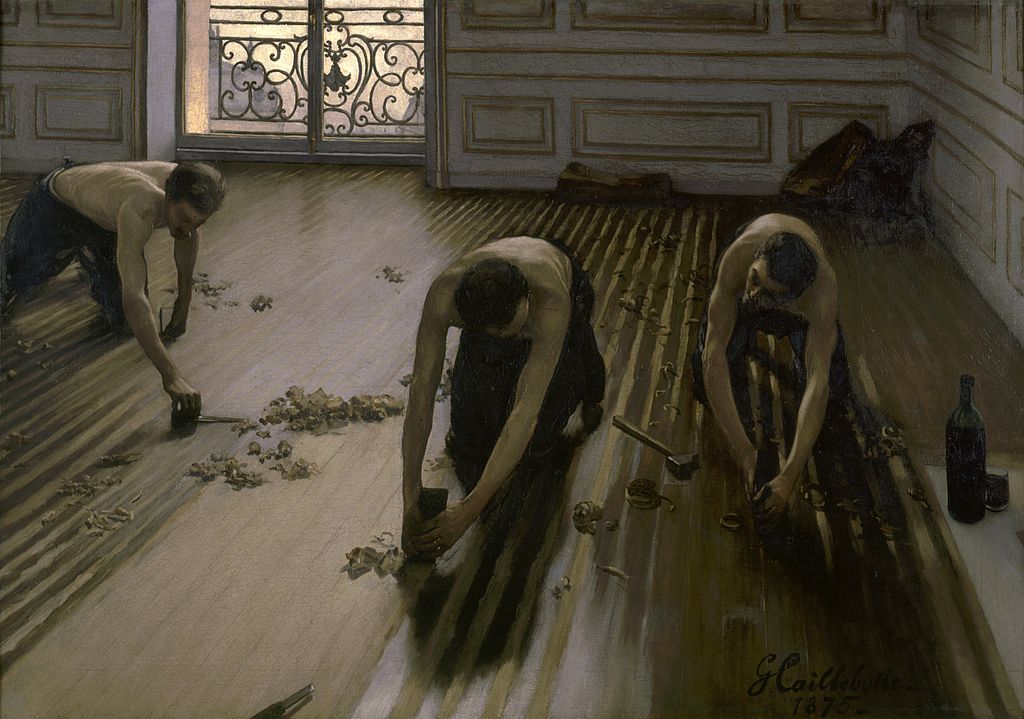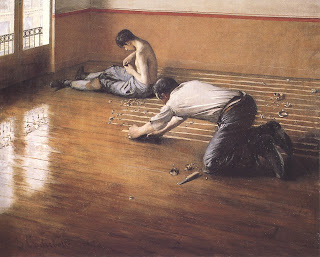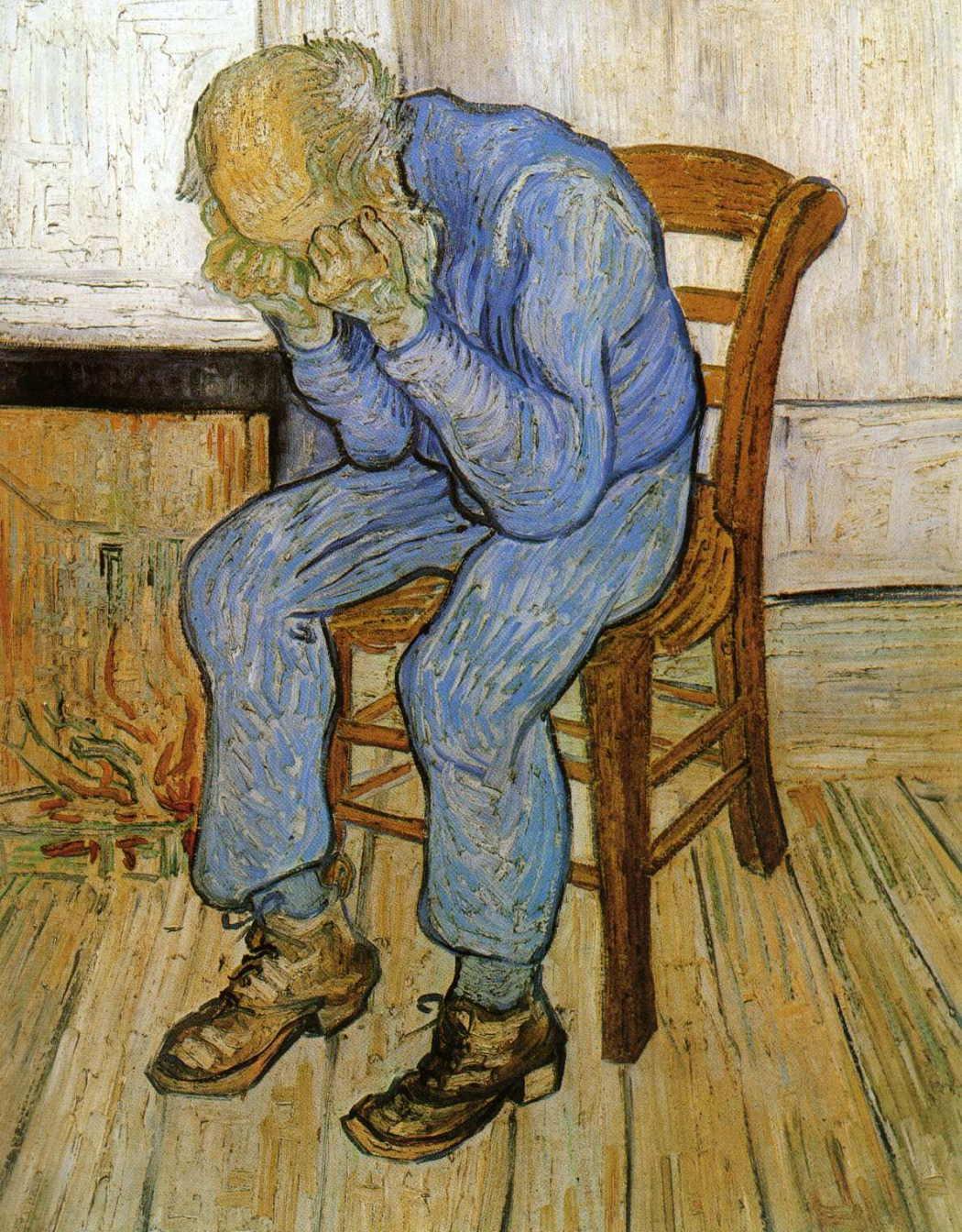
The Floor Scrapers and the Making of Caillebotte’s Masterpiece
 |
| Gustave Caillebotte, The Floor Scrapers, 1875 Musée d’Orsay, now on view at the National Gallery of Art, Washington, |
Right now the National Gallery is having an exhibition of an Impressionist whose reputation has grown over the last 25 years, Gustave Caillebotte. Gustave Caillebotte: The Painter’s Eye will be on view until October 4.
It’s interesting how his first masterpiece, The Floor Scrapers was rejected by the Salon in 1875, but part of the Impressionists’ exhibition the next year. The masterful painting granted Caillebotte entry into the Impressionist group. He repaid his dear friends by buying up many of their works and then donating them to the French state after he died. Many of the paintings he owned are part of Paris’ great early modern museum, Musée d’Orsay. It’s appropriate that the museum that houses so many Impressionist works is a former train station, since modern trains inspired viewers to observe the transient views of the world that the Impressionists transience painted so well.
There are so many reasons The Floor Scrapers is my favorite work by Caillebotte. The composition is extraordinarily well balanced with an artful asymmetry. There’s the tilted floor plane, a view that artists would only start to use after they discovered photography and how it frames pictures differently. There’s also the dignity given to labor and the beautiful anatomy.
Finally it’s incredible to see how Caillebotte painted tactile contrasts on wood in the various stages of sanding, what looks like with or without varnish, and in the light and shadow. Compared to the other Impressionists, Caillebotte painted with definition and a moderate amount of precision. Yet when he illuminates the floor with natural light from the window, we see a wonderful scintillating values, colors and textures. Yellow shines through with touches of blue, but in the distance it becomes an earthy brown.
To understand how good this painting actually is, it’s useful to compare it with another version of floor scrapers that he did. It’s a simpler composition from a different angle, with fantastic lighting effects. Enlarging the photo here will really show off the reflections on the floor. (It isn’t in the National Gallery’s show, but was also part of the 2nd Impressionist exhibition in 1876.)
 |
| Caillebotte, The Floor Scrapers |
Many of Caillebotte’s other paintings in the exhibition give us a view into his amazing sense of perspective: Le Pont de l”Europe, 1876, for example. He lived at the time that Paris had just experienced a major rebuilding campaign. Paris, A Rainy Day gives an impressive viewpoint of how the new city must have looked to the public, in the eyes of a new bourgeoisie class. Since streets corners were set up in star patterns, the linear perspective has multiple vanishing points and appears to go very deep. The even greater and more famous artist, Georges Seurat, borrowed from the composition of Paris: A Rainy Day when he did his iconic narrative painting of Paris on a sunny day, Sunday Afternoon on the Island of the Grande Jatte.
Monet and Van Gogh are two more prominent artists who shared Caillebotte’s deep perspective space. Degas went even further than Caillebotte to exploit the unusual viewpoint. Right now there is an important Impressionist exhibition is in Philadelphia, Discovering the Impressionists, until September 13. The exhibit showcases Paul Durand-Ruel, the art dealer who took a gamble and went into great financial risk by buying up Impressionist painters because he believed in them. The exhibit includes Monet’s beautiful Poplars series. However, one of the really important works in the group is by Degas, The Dance Foyer at the Opera on the rue Le Peletier.
 |
| Edgar Degas, The Dance Foyer at the the Opera on the rue Le Peletier, 1872, Musée d’Orsay, Paris, now on view at the Philadelphia Museum of Art |
This panoramic ballet scene of dancers offers a wonderful comparison with the Caillebotte, The Floor Scrapers. This painting is also asymmetric and appears to look spontaneous, while it is actually exceptionally well-planned. Degas offers many more layers of observation: into another room and out the window, through a mirror (?) or another room in the back center. We imagine that the major source of light is a an unseen window to the right. Whites and golds predominate the scene, with touches of blue and orange. Degas’s dancers, though quite strong may seem delicate next to Caillebotte’s muscular workers. In truth, Degas’ dancing girls and Caillebotte’s hard-working men are much the same. Their work is a labor of love, as the Impressionists saw it. The same can be said about Caillebotte, Degas, Durand-Ruel and those who left us with a wonderful record of life in Paris in the 1870s. The ballet painting was done in an opera house that destroyed by fire the very next year, probably caused by gaslights.







Recent Comments